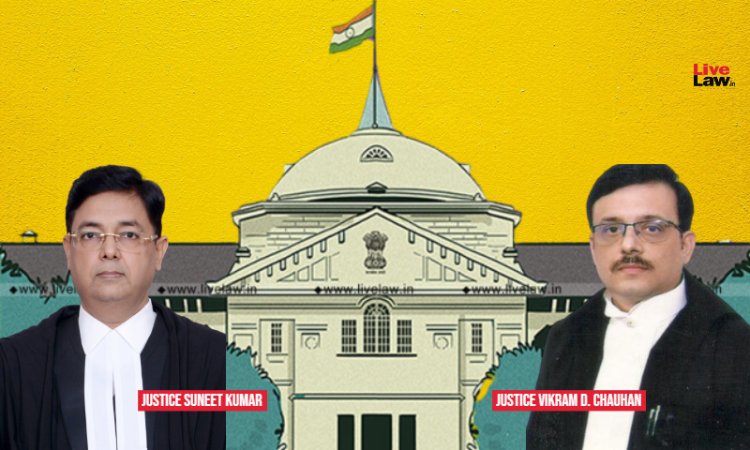- Home
- /
- News Updates
- /
- Carrying Firearm To Place Of...
Carrying Firearm To Place Of Occurrence Indicates Intention Of Accused To Cause Death: Allahabad HC Upholds Murder Conviction
Sparsh Upadhyay
12 Jan 2023 9:06 AM
The Allahabad High Court recently upheld the conviction and life sentence awarded to two men for killing a man with a country-made pistol in the year 2005. The court said that the act of the accused carrying a firearm weapon at the place of occurrence was itself indicative of their intention to cause death or such injury as is likely to cause death. The bench of Justice Suneet Kumar...
The Allahabad High Court recently upheld the conviction and life sentence awarded to two men for killing a man with a country-made pistol in the year 2005.
The court said that the act of the accused carrying a firearm weapon at the place of occurrence was itself indicative of their intention to cause death or such injury as is likely to cause death.
The bench of Justice Suneet Kumar and Justice Vikram D. Chauhan also noted that the nature of the injury and the body part, where the injuries were sustained, indicated that the Accused-Appellant fired on the deceased with the intention of causing injury as is likely to cause death or the injuries were sufficient in the ordinary course of nature to cause death.
Consequently, the Court dismissed an appeal moved by the accused challenging the October 2010 judgment and order passed by the Special Judge (DAA), Agra convicting them under Section 302/34 and Section 394 IPC and sentencing them to undergo life imprisonment.
The case in brief
As per the prosecution’s case, on June 23, 2005, at around 6 PM when the informant was going to meet his son Arif (deceased), he heard a distress call made by one Amar Nath (PW4) saying that his bag was snatched away by the accused-appellants.
Hearing the call, the informant, the deceased, and others ran towards the two Appellants, who were engaged in a robbery of the bag and the deceased (Arif) caught hold of one of the accused persons. However, he fired on him and as a result of the same, he sustained a firearm injury.
The deceased was taken to the hospital where he died. Since Kailash was caught by the prosecution witnesses, he disclosed the name of the Appellant-Baba Thakur alias Baba Sindhi.
The trial court convicted both the accused as it relied upon the testimonies of P.W.4 (whose bag was robbed), P.W.1 (father of the deceased), and P.W.2 (who is the brother of the deceased). The Court also noted that there was no enmity between Appellants and P.W.1 & P.W.2.
Challenging their conviction, the appellants moved to the High court.
High Court’s observations and order
Perusing the evidence and material on record, the Court noted that the accused persons had been identified by the eyewitnesses as the perpetrator of the crime before the trial court and the same was corroborated by the test identification parade.
The Court also noted that witnesses in the case had ample opportunity of seeing the accused at the time of the commission of the offence and there was no chance of mistaken identity, and therefore, delay in holding the test identification parade may not be held to be fatal.
However, regarding the argument that even if appellant no. 2 was present at the place of occurrence, even then he could not be convicted for the offence of Murder as there was no intention to commit murder and the common intention was to commit robbery and run away.
It was argued that appellant no. 1 fired at the deceased in order to save himself and as such the provisions of section 34 IPC would not be attracted to convict Appellant-Baba Sindhi under section 302 IPC.
However, rejecting this argument, the Court observed thus:
“The criminal offence was attributable or connected or possible outcome of the preconcert/contemporaneous engagement or a manifestation of the mutual consent for robbery and it will fall within the scope and ambit of the act done in furtherance of common intention. The Appellant – Kailash has fired on the deceased in the act of committing robbery and as such co-accused baba Thakur will be liable for such act has been done in furtherance of the common intention of committing an offence and would come within the scope of Section 34 of the Indian Penal Code. It is to be noted that the Appellant-Kailash was carrying a fire arm while committing robbery itself is indicative of intention of the Appellants at the time of committing of crime.”
Regarding the argument that the case would fall under Section 304 (II) IPC as Kailash had not fired with the intention to cause death, and it was done in a sudden fight, the Court made the following observations:
- -The doctor who conducted the post-mortem in his testimony before the trial court has stated that the death could have occurred as a result of antemortem injuries sustained by the deceased.
- -The blackening and tattooing was present on the injury sustained by the deceased. The aforesaid is indicative of the fact that the firearm weapon was used from close range.
In view of this, the Court came to the conclusion that the Appellant-Kailash fired on the deceased with the intention of causing injury as is likely to cause death or the injuries were sufficient in the ordinary course of nature to cause death and that the injuries were imminently dangerous that it must in all probability cause death or such bodily injury as is likely to cause death.
Consequently, the Court upheld their conviction and dismissed their appeals.
Case title - Kailash vs. State of U.P along with a connected appeal
Case Citation: 2023 LiveLaw (AB) 12

